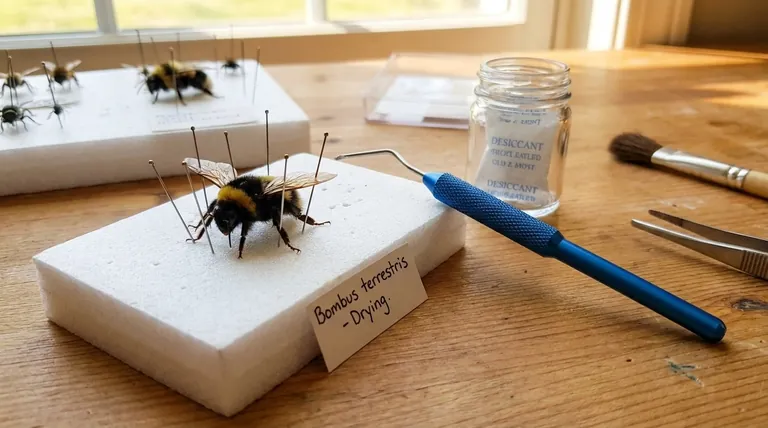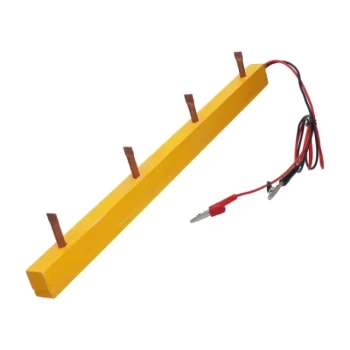As a general rule, pinned bee specimens require a minimum of 3 to 7 days of air drying to be properly preserved. This timeframe is crucial for ensuring the internal tissues dehydrate completely and the exoskeleton hardens, permanently locking the bee’s carefully arranged legs, wings, and antennae in place.
The key to successful preservation is not simply counting the days, but understanding that the goal is to achieve complete rigidity. The 3-7 day window is a reliable starting point that you must adjust based on the bee's size and your ambient environmental conditions.

Why Proper Drying is Non-Negotiable
A specimen that is not thoroughly dried is a specimen that will inevitably be lost. The drying process is a critical race against time to halt natural decomposition and secure the specimen's scientific and aesthetic integrity.
Preventing Microbial Decay
Moisture is the primary catalyst for decay. Leaving it within the specimen invites the growth of mold and bacteria, which will quickly break down the internal structures and ruin the bee from the inside out. Thorough drying removes the water these microbes need to survive.
Setting the Final Position
When you first pin a bee, its joints are flexible. The drying process hardens the entire exoskeleton and all connecting tissues. This is what makes the posed position permanent, preventing legs or antennae from slumping or moving later on.
Ensuring Long-Term Stability
An incompletely dried specimen remains vulnerable. Changes in temperature or humidity can cause it to relax, shift, or even begin to decompose months or years after it has been placed in a collection.
Key Factors That Influence Drying Time
The 3-to-7-day guideline is not absolute. Several variables can significantly shorten or lengthen the time required for a specimen to become fully inert.
Specimen Size
This is the most significant factor. A large carpenter bee or bumblebee contains far more internal moisture than a small sweat bee. Larger specimens will always require more time and should be left for the upper end of the time range, or even longer.
Ambient Humidity
High humidity in the air will dramatically slow the rate of evaporation from the specimen. In a damp or tropical climate, you may need to extend drying time well beyond a week. Conversely, a very dry, arid environment will accelerate the process.
Airflow
Gentle, consistent airflow helps wick moisture away from the specimen's surface, speeding up dehydration. Placing the pinned bee in a well-ventilated room is beneficial, but avoid direct, strong airflow from a fan, which can damage delicate parts.
Common Pitfalls to Avoid
Rushing the process or using improper techniques can cause irreversible damage. Understanding the trade-offs between speed and quality is essential.
The Risk of Under-Drying
This is the most common mistake. A bee that feels dry to the touch may still retain significant moisture deep inside its thorax or abdomen. This leads to mold, foul odors, and parts slumping out of position weeks later. When in doubt, always give it more time.
The Danger of Artificial Heat
Never use a heat lamp, oven, or direct sunlight to speed up drying. While it may seem efficient, rapid heating makes the exoskeleton extremely brittle. This causes antennae and legs to become fragile and snap off with the slightest touch.
Choosing the Wrong Location
A dusty or pest-prone area is a poor choice for drying. The specimen is vulnerable during this stage. Choose a clean, stable, indoor location where it will not be disturbed. For humid environments, placing the pinning block inside a sealed container with a desiccant like silica gel can create an ideal drying chamber.
Making the Right Choice for Your Specimen
Instead of relying solely on the calendar, use these guidelines to judge when your specimen is truly ready for long-term storage.
- If you are working with large bees (e.g., bumblebees or carpenter bees): Plan for at least 7 days and check for absolute rigidity in the abdomen before moving it.
- If you are in a high-humidity environment: Extend the minimum drying time by several days or use a sealed container with a desiccant to create a controlled dry environment.
- If you need absolute certainty: Gently touch a tarsus (the final segment of the leg) with a fine pin; if there is any softness or flex, it needs more time.
Ultimately, patience is the primary tool for creating a scientifically valuable and stable specimen that will last for generations.
Summary Table:
| Factor | Effect on Drying Time |
|---|---|
| Specimen Size | Larger bees (e.g., bumblebees) require more time (7+ days). |
| Ambient Humidity | High humidity slows drying; low humidity speeds it up. |
| Airflow | Gentle, consistent airflow helps; avoid strong drafts. |
Create museum-quality specimens with the right tools. Proper preservation starts with reliable equipment. HONESTBEE supplies durable, professional-grade beekeeping and specimen preparation supplies to commercial apiaries and equipment distributors. Ensure every specimen in your collection is perfectly preserved—contact our experts today to discuss your wholesale needs.
Visual Guide

Related Products
- Stainless Steel Queen Grafting Tool for Beekeeping and Bee Queen Grafting
- HONESTBEE Professional Bee Frame Machine for Side Bar Shaping
- HONESTBEE Professional Cabinet Bottle Dryer
- Plastic Chinese Queen Grafting Tool for Bee Queen Rearing
- HONESTBEE Professional Telescopic Pole Bee Swarm Catcher
People Also Ask
- How does the company ensure the accessibility of its premium products? Decoding Financial vs. Technical Access
- What happens if a larva is grafted too late? Avoid Scrub Queens and Failed Rearing
- What are the steps involved in using a queen grafting tool? A Guide to Successful Queen Rearing
- What are orientation flights for virgin queens? The Essential Guide to Queen Bee Navigation
- What is the purpose of queen rearing frames? Master Controlled Queen Production for Your Apiary



















